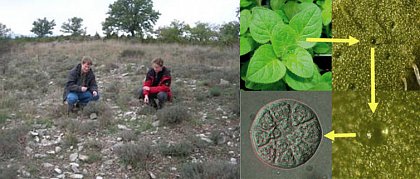The biosynthesis of terpenes in Lamiaceae
The essential oils of mint, sage, oregano and thyme have important pharmaceutical uses and are widely used as flavoring compounds for food and cosmetics. These essential oils consist mostly of monoterpenes but often show substantial qualitative and quantitative differences within a single species. Natural populations of both thyme and oregano each consist of several chemotypes that have an identical morphology but are defined by differences in their terpene profile. Due to these differences in terpene content, the chemotypes differ in their resistance to particular herbivores and appear to be localized in the environments with the herbivore communities that they are best defended against.
The goal of our study is to understand the evolution of chemotypes and the genetic mechanisms that maintain the distinct chemotypes in mixed populations of thyme. Classical genetic studies on thyme demonstrated an epistatic series of six loci that define each of the chemotypes. We are extending these studies towards the molecular genetics and biochemistry of chemotype formation with the aim to characterize the biosynthesis of terpenes and the mechanisms that regulate chemotype formation in the plant.

Chemotype formation in Lamiaceae. Right panel: Assessing chemotypes in a natural population of thyme. Left panel: Lamiaceae terpene oils are formed in glandular trichomes on the leaf surface. Clockwise: Origanum leaf, leaf surface with glandular trichomes, close up of a glandular trichome, an isolated glandular trichome with eight gland cells. (Photos by Christoph Crocoll)

